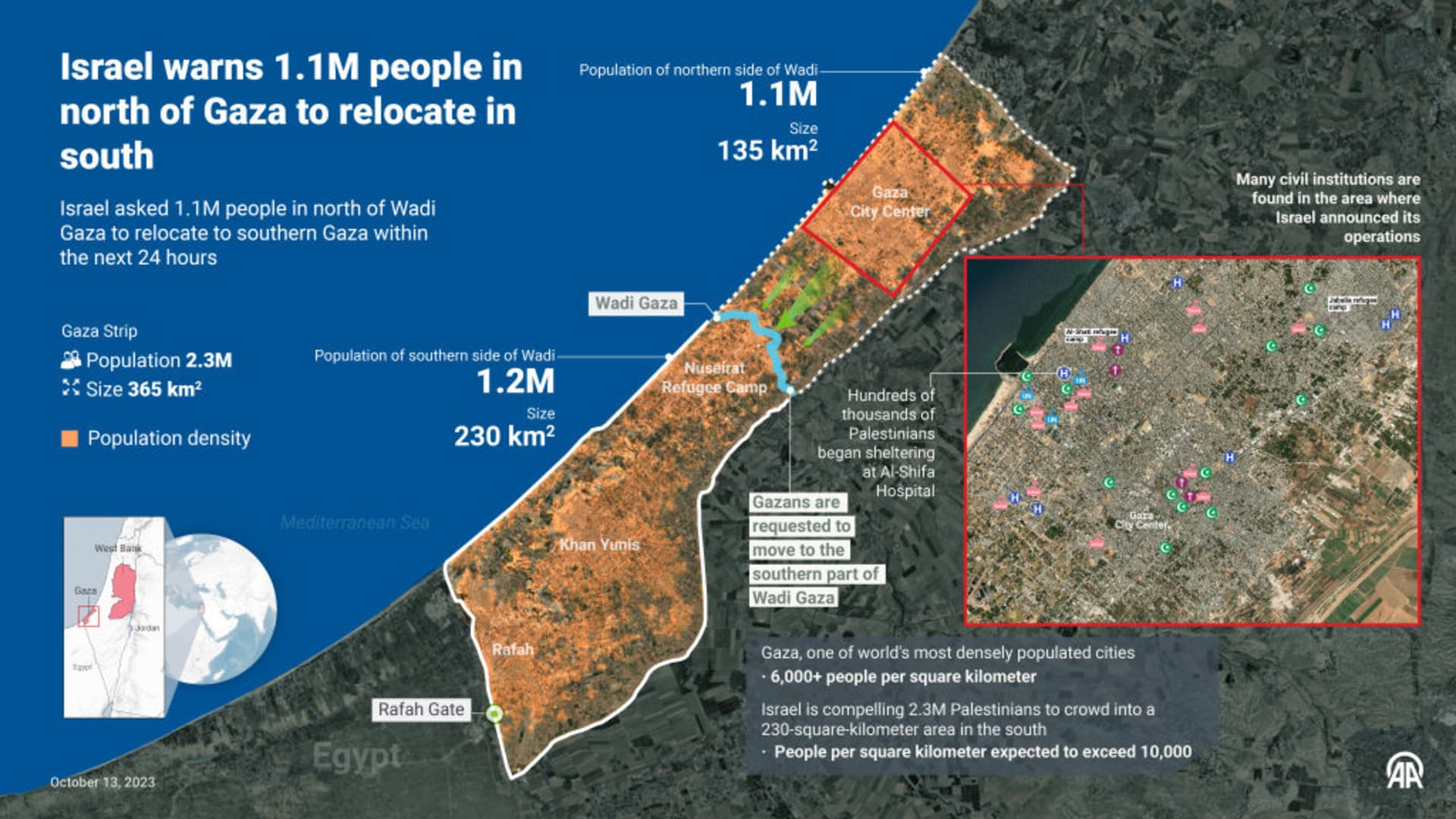
- In response to the Oct. 7 terrorist attacks of Hamas, Israel has urged 1.1 million people living in northern Gaza to evacuate south ahead of a major ground invasion.
- Ahead of such an attack, one military geography specialist outlined to CNBC how the geography of the Gaza Strip could influence any fighting.
Israel is widely expected to launch a major ground offensive into Gaza in the coming days, seeking to "demolish" the Palestinian militant group Hamas after a coordinated attack on southern Israeli border towns that sent political shock waves across the region.
In response to the Oct. 7 terrorist attacks of Hamas, Israel has urged 1.1 million people living in northern Gaza to evacuate south ahead of a large ground invasion. The United Nations has called the evacuation order "impossible" without "devastating humanitarian consequences."
Ahead of such an attack, one military geography specialist outlined to CNBC how the physical features of the Gaza Strip could influence any fighting.
Get top local stories in DFW delivered to you every morning. >Sign up for NBC DFW's News Headlines newsletter.
Francis Galgano, an associate professor at the Department of Geography and the Environment at Villanova University in Pennsylvania, described Gaza as an essentially flat, "heavily urbanized" and "heavily tunneled" coastal enclave, similar in size to the city of Philadelphia.
In his view, Israel's impending ground incursion "is going to be a mess" but ultimately a battle that its forces should be able to get under control. He warned, however, that any kind of ground offensive from Israel's military would be a highly dangerous "cat and mouse game" of urban warfare, one with a particularly unique subterranean element.

The Gaza Strip is a narrow portion of land sandwiched between Israel, Egypt and the Mediterranean Sea. It is one of the most densely populated places in the world, with more than 2 million people living in conditions that human rights organizations have equated to an "open-air prison."
Money Report
"The geography of this is that [Israeli forces are] going to cut Gaza off from the rest of the country and then they are going to move into Gaza City and then you're in urban warfare," said Galgano, who retired from the U.S. Army in 2007 as a lieutenant colonel after 27 years of service in tank and cavalry units.
From a military perspective, Galgano said that the "operational environment" for Israeli forces in Gaza would be crowded city streets, tall buildings, basements and a network of underground tunnels in what is already a "very compressed geographic area."
"As much as it becomes a war of infantry, in artillery and the air force, it becomes a war of the geologist. Geologic information becomes essential because you're trying to figure out rock formations," Galgano said.
"Where are the tunnels? How do we locate them? Using ground penetrating radar and what can we do to destroy them rather than necessarily sending soldiers in there to winkle people out, which is always very dangerous."
Galgano said one particularly interesting aspect of Israel's expected invasion that is too often overlooked is that "geology and warfare now become a nexus in this type of operation."
Hamas 'will not exist in the Gaza Strip'
Speaking on CNBC's "Capital Connection" last week, the former head of Israel's National Security Council told CNBC that a ground offensive was needed due to Hamas' intricate network of underground tunnels.
"After the operation, Hamas as an organization will not exist in the Gaza Strip, we will kill as many as possible of its members, and we will destroy every facility of the organization," said Yaakov Amidror, a retired major general and former national security advisor to Israel Prime Minister Benjamin Netanyahu.
"We have to destroy Hamas on the ground to find Hamas members within the underground tunnels, in the holes, in their headquarters," Amidror said Friday.
Israel's intelligence community believes much of the support and funding the world gave to the people of Gaza to rebuild after previous wars has been taken by Hamas and reinvested in an elaborate system of tunnels and bunkers.
Indeed, Galgano said Hamas' likely best defense against Israel's forthcoming ground offensive would be to stay underground in its tunnel system.
"This is a very unique battle because of this intersection of geology and warfare so I think that will be really a key to this whole thing. It is probably where they have got most of their hostages hidden, it's where their supplies are hidden, their command posts will be hidden under there," Galgano said.
The Israeli military has said 155 people are being held hostage by Hamas since the Oct. 7 surprise attack on Israel.
"There's a lot of discontinuities underground, you've got layers of shale and sandstone ... These are all different layers of different densities and they either enhance or degrade ground penetrating radar or other remote sensing systems that you'd want to use to detect them," he continued.
"It really is a cat-and-mouse game," Galgano said. "The Israeli's know the geology of the area and in the end, it is a finite border and there are only so many places that are really prime real estate for tunneling. So, I think ultimately the Israelis will get this under control but it's going to take an effort."
— CNBC's Lee Ying Shan contributed to this report.






